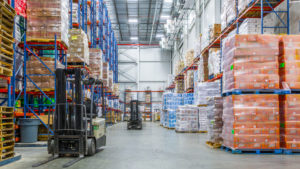Cold Storage
Ware house & cold storage can store live stocks & food products for short & long term storages. Warehouse & cold storage can easily maintain required temperature, humidity & cleanliness. But it is very difficult to maintain safety & hygiene. It is important to maintain micro trial count under control or else shelf life & quality gets significantly affected. Main challenge in warehouse & cold storage is to control mold, fungi’s, air bone bacteria & viruses.
Use of control dose of gaseous ozone in air handling system can significantly control the growth of mold, fungi’s, and micro organisms. Originally ozonated cold storage did not allow growth of mold & fungi’s. if mold & fungi are already present in food, ozone starts recovery them & also removes odor produced by them. Lower temperature in cold storage slows down the opening process. Some fruits like apple & banana releases ethylene gas during slow ripening process & ethylene in the air can accelerate the ripening process. Use of ozone in cold storage reacts with ethylene & slows the ripening process.

ECHIP integrated ozone system [IOS] in-plug & play type, easy to install in the existing air handling system of cold storage. ECHIP design team can make a suitable design to retrofit air ozone system, in existing facilities. In case of godowns & warehouses, integrated ozone system can be installed with air circulation system for maximum performance.
Unlike ultraviolet light in which only air that comes in visible contact can be disinfected. Ozone being gas goes into each and every part of stored food grains & live stock. Ozone quickly surrounds the object & maintains very high degree of disinfection.
Cold storage rooms hold various types of foods including vegetables, fruits, meats, sea foods, etc. The temperatures vary from low cool to way below freezing. All food products, being highly degradable, start breeding bacteria. At low temperatures, bacterial activity is slowed down, bacteria may be inactivated, but not destroyed. Atmospheric bacteria anchor on the surfaces of foods and attack them releasing acids which slowly spreads further inside decaying the food. At low temperatures, this process is slowed down. Controlling or destroying these bacteria helps in maintaining the foods fresher for far longer. Using disinfectants helps in controlling the bacterial activity, but the disinfectant used should not become a part of the food when consumed. Ozone has been found to be of tremendous advantage in such cold storage rooms for better maintenance of stored foods.
Injecting ozone in the air inside the cold storage rooms maintains the environment inside bacteria free. As a result the bacterial activity on the surfaces of foods under storage is minimal. It has also been found that vegetables, fruits, meats, sea foods, even eggs washed in ozonised water increases the shelf life of these products. This is because ozone destroys the surface bacteria which are present on all the foods, thus reducing the bacterial activity on the surfaces of the foods. This further helps in reducing the decaying process while increasing the shelf life. The same principle holds good in applying ozone in the environment inside the cold storage rooms. The foods store fresher and longer with ozone than without it inside the cold storage rooms. The safe factor is that since ozone has a very short half life, there is no toxicity either in the foods nor in the environment.

